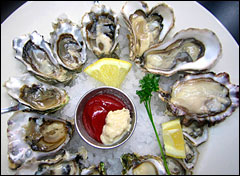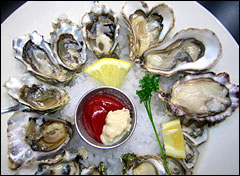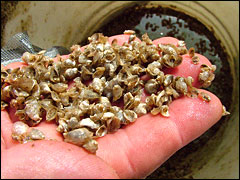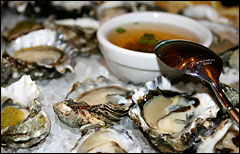I’ve lived in Boston for years, but for some reason, I had never visited nearby Portland, Maine — until last week, that is. I chose a dramatic occasion for my Portland debut: an Oyster Tasting Night put on by Slow Food Portland.
My previous opinion about the celebrated bivalve was decidedly lukewarm. My lack of oyster enthusiasm once even forced me to consider the specter of parental disownment. Having avoided oysters for years, I ate my first one when I was in Denver in my early 20s. I called my Baltimore-born, oyster-obsessed dad afterward to boast I had finally tried an oyster. He responded that anyone who ate her first oyster in high, dry Denver after being raised on the shores of Long Island Sound was, and I quote, “not my child.” What can I say? He really liked oysters. As for myself, I could take them or leave them.
Since then, I’ve had them on several occasions, sometimes with cocktail sauce, sometimes with a mignonette (a light, shallot-flavored vinaigrette), and a few times I’ve let them slide down my gullet unadorned. I never chewed them or rolled them around in my mouth, and it seemed odd to me to eat a food without savoring it. What’s the point of eating something if you don’t take the time to enjoy the taste or texture? Still, I felt motivated to give oysters another chance, and what better time and place than an oyster-tasting night presented by people who are dedicated to preserving local food traditions?
Consider the oyster
The event was held at One Longfellow Square, a small, storefront performance space in Portland. I went with my friend David, a Slow Food member, and we arrived just as a few oyster farmers were beginning to shuck massive quantities of oysters while other folks decorated the tables and set out various sauces and baskets of bread. The Hot Club of Portland (a trio consisting of a standing bass, guitar, and violin) tuned up, and Slow Food members and volunteers arrived, bought tickets, and started lining up to sample the four featured oyster varieties.
I tried them all — Winter Point, Dodge Cove, Portage Island, and Glidden Point — and found that they tasted perceptibly different from one another. The first and most striking thing that I noticed about them was how fresh and plump they were. (Some of them had been taken out of the water earlier in the day.) They glistened as they slid about in their liquor when I gently tilted their shells from side to side.
I decided to forgo any sauce on the oysters so that I could taste them in their purest form. They were all slightly salty, but some had a lighter, cleaner taste while others had a deeper, brinier flavor and tasted as if they were more connected to the sea.
Interestingly, this turned out to be the case: some of the oysters were from farther up the estuary, closer to where the freshwater of the Damariscotta River meets the salt water of the sea, whereas others were from farther out on the coast. I was thinking that this should be referred to as “meroir” (the taste of the sea, taken from the French word for the sea, “la mer”) vs. the landlocked version, “terroir,” which means the taste of the place in which a food is grown that is ultimately detectable in that food’s unique flavor. (Later that evening, however, it was revealed that some people have already employed that nomenclature, so I can’t claim to have invented it. Shucks!)
Oyster 101
This was an educational event as well as a tasty one, and the first speaker was Dana Morse, an extension agent for the Maine Sea Grant and University of Maine Cooperative Extension. One of his responsibilities is teaching people to become “oyster gardeners” — people who maintain oyster beds for their own enjoyment rather than for commercial purposes.
Dana briefly outlined the life cycle of the oyster: breeding-stock oysters are put into an indoor tank where the rhythm of the tides is mimicked by changing the temperature of the water, causing the oysters to express their eggs and sperm. (“We turn the lights down low and put on some soft music,” he joked.) Although an oyster’s gender can’t be determined simply by looking at it, the eggs and sperm look different enough so that once the oyster expresses one or the other, the oyster is then moved into a tank by itself.
Eventually, male and female oysters are combined in ratios that will ideally result in the greatest number of fertilized eggs. Once the fertilized eggs begin to grow, they are taken to baskets in the water where they will stay until they are harvested, typically 18 months to two years.
Dana pointed out that because oysters are filter feeders they do not need to be “fed,” as some aquaculture species do, and thus don’t foul the water with excess nutrients. The oysters actually clean and improve the water where they are grown. Very little in the way of fossil fuels is used in either growing or harvesting oysters, so they are a very low-impact form of aquaculture.
The next speaker was Rowan Jacobsen, author of A Geography of Oysters: The Connoisseur’s Guide to Oyster Eating in North America. Rowan had his first oyster during Happy Hour at Stormy’s, a bar in New Smyrna Beach, Fla., at age twelve. He ate his first oyster as a sort of a dare to himself (and also to impress his younger brothers), but he developed a taste for them and his lifelong interest in oysters was sparked that afternoon.
Rowan lives in Vermont, where he works as a writer for The Art of Eating, but he traveled widely to research his book. He started in Puget Sound, which he says is a mecca for oyster growers, citing the large number of oyster farms there.
Next he returned to New England, where he checked out the Moonstone oyster in Rhode Island, and the Glidden Point, in coastal Maine. He then visited the Chesapeake to monitor the current status of the oysters there. That area’s once-famous oysters have fallen on hard times, due to the severe pollution of the Chesapeake Bay.
“When explorers first arrived in the Chesapeake, the water was crystal clear and teeming with fish and shellfish,” he explained. “At that time, the oysters were completely filtering the bay every two to three days. Oyster reefs were so high then — sometimes 20 feet — that they represented a hazard to shipping.”
Not just for slurping
This got me wondering about oysters’ potential use purely as filtering mechanisms, rather than for consumption. Rowan said that oysters have indeed been used to clean water, and mentioned the Drayton Harbor Community Oyster Farm in Washington state. The oyster farm is a project of the Puget Sound Restoration Fund and it was founded in order to clean the water and raise public awareness regarding pollution. Water quality was so poor at one point that it wasn’t safe to harvest shellfish. According to Geoff Menzies, manager of the oyster farm, the water is now clean enough to receive conditional approval for shellfish harvest dependent upon rainfall. Except after heavy rains that wash in excess toxins, the farm sells the oysters to support their work on improving water quality.
Needless to say, in places where oysters are filtering high concentrations of toxins, you wouldn’t want to eat them. But under normal circumstances, they pose no special threat. In fact, one major concern related to eating seafood, exposure to mercury, does not apply to oysters. Because they are so low on the food chain, oysters contain very little of that dangerous heavy metal; unlike top-feeders like tuna, oysters don’t accumulate mercury since they don’t usually eat anything that contains it. Rowan says that the chance of becoming ill from eating raw oysters is really quite slim, as long as you stay away from oysters that grow in warm water. He advises, “Stick to cold-water northern oysters and your risk is virtually nonexistent.” He adds that buying them from a reputable retailer who follows state code in handling oysters is critical.
Rowan also noted that oysters are incredibly efficient producers of protein: they produce five to six times more protein per acre than cows. Oysters contain so many vitamins, he adds, that they are a bit like a naturally occurring multivitamin pill.
I asked him what oysters he would recommend to someone who was just starting out on his or her oyster-eating career. He suggests the Beausoleil, a small “cocktail” size oyster (approximately 2.5 inches) from New Brunswick, Canada, that has a light, fresh taste and no strong flavors. The Beausoleil is widely available.
He also recommends Kumamotos, a species related to the Pacific oyster that is small in size, has a deep cup, and is highly regarded for its sweet, melon-like flavor. For further recommendations, check out his list of suggestions based on one’s previous oyster-eating history and personality traits.
Rowan was kind enough to let me reprint two recipes from his book, one for oyster stew and another for an iced Champagne mignonette. When we spoke on the phone, Rowan told me that he had made a version of the simple oyster stew just the night before using about 16 oysters and a third of a cup of cream, but that he had added a small shallot and two shakes of Cajun seasoning. He sounded incredibly content, and perhaps even a little bit wistful, when he described it.
Now that I’ve had a positive experience with truly fresh and delicious oysters, I can’t wait to have some more. I’ll be dropping by some local seafood places — and, for the first time ever, heading for the raw bar. I will also attempt to relive my oyster epiphany by heading back to Portland as soon as I can. This time, I’ll be bringing along my copy of A Geography of Oysters — an incredibly diverting and useful guide.
Oyster Stew for Dummies
Serves 4-6 as a first course
1 pint (500 ml) heavy cream (ideally not ultrapasteurized)
2 tablespoons (30 g) butter
Salt and pepper
Optional garnishes: paprika, minced parsley, hot sauce, Worcestershire sauce, and oyster crackers are all acceptable. A pat of butter on top is glorious, if decadent.
- Warm the cream and oyster liquor in a pot or saucepan.
- In a soup pot, melt the butter over medium heat. Add the oysters and cook just until their edges begin to curl. (If using the paprika it can be added with the oysters or sprinkled at the end.)
- Add the cream, stir, and heat to the edge of boiling. When the oysters have plumped, turn off the heat. Boiled oysters turn tough.
- Adjust the seasoning, garnish as you please (or let your guests do their own), and serve.
(Reprinted from A Geography of Oysters.)
Elliott’s Iced Champagne Mignonette
Makes 2 cups
Rowan writes: “When you plunk yourself down at Elliott’s, on the Seattle waterfront, and order some oysters, you will be presented with a single sauce: their signature Iced Champagne Mignonette. Nothing else compares. By transforming a mignonette into a granita by carefully freezing it, you get a sauce that obediently stays atop its oyster. And the ice crystals serve as tiny flavor capsules, bursting in your mouth with lemony tartness.
2/3 cup (150 ml) red wine vinegar
2/3 cup (150 ml) rice wine vinegar
1 and 1/2 cups (150 ml) Mumm’s Champagne
1 and 1/2 teaspoons (8 g) minced lemon zest
1 teaspoon (3 g) finely ground black pepper
1 teaspoon (3 g) finely ground mixed peppercorns
- Combine all the ingredients in a bowl and place the mixture in a shallow pan so it is only one inch (2.5 cm) deep.
- Place the pan in the freezer. Every half hour, until it is completely frozen, agitate it by scraping with a fork to break up the ice crystals. The final product should look like shaved ice. Keep covered until serving.
(Reprinted from A Geography of Oysters.)
The following two recipes are courtesy of Leslie Oster and Aurora Provisions, of Portland, Maine:
Cilantro Caper Cocktail Sauce
1 cup chili sauce
1 small red onion, finely chopped
juice of one lemon
1 cup capers
2 cloves garlic, finely chopped
3 tablespoons chopped cilantro
Salt and pepper to taste
Combine all ingredients and adjust the seasoning to taste with the salt and pepper.
Pickled Ginger Mignonette
1 cup mirin
1/4 cup sugar
2 shallots finely chopped
1/4 cup pickled ginger, finely chopped
pinch of salt and pink peppercorn
Heat vinegar, mirin and sugar until sugar is dissolved, add shallot and ginger, cook for 5 minutes. Add salt and pepper. Chill.





